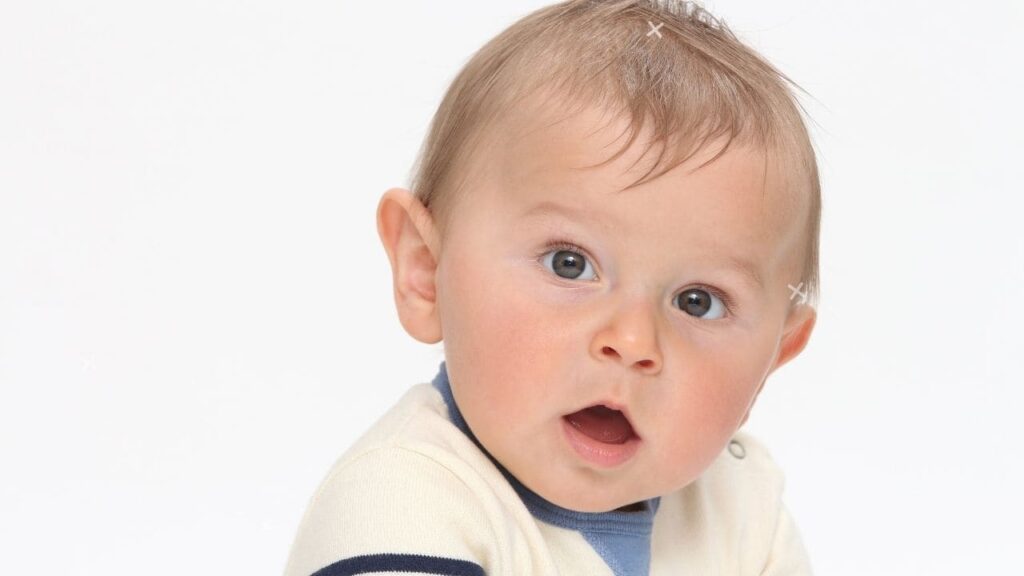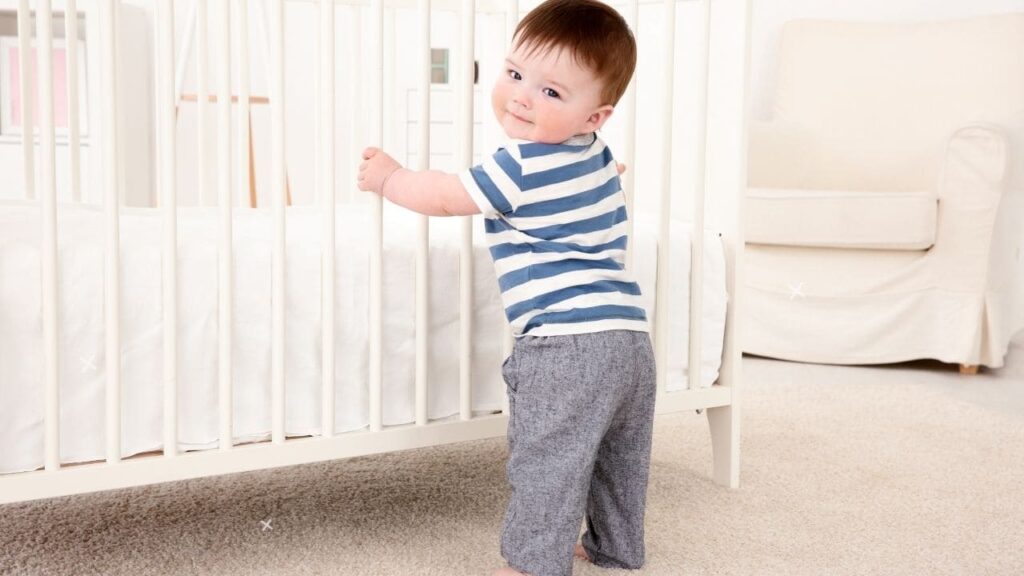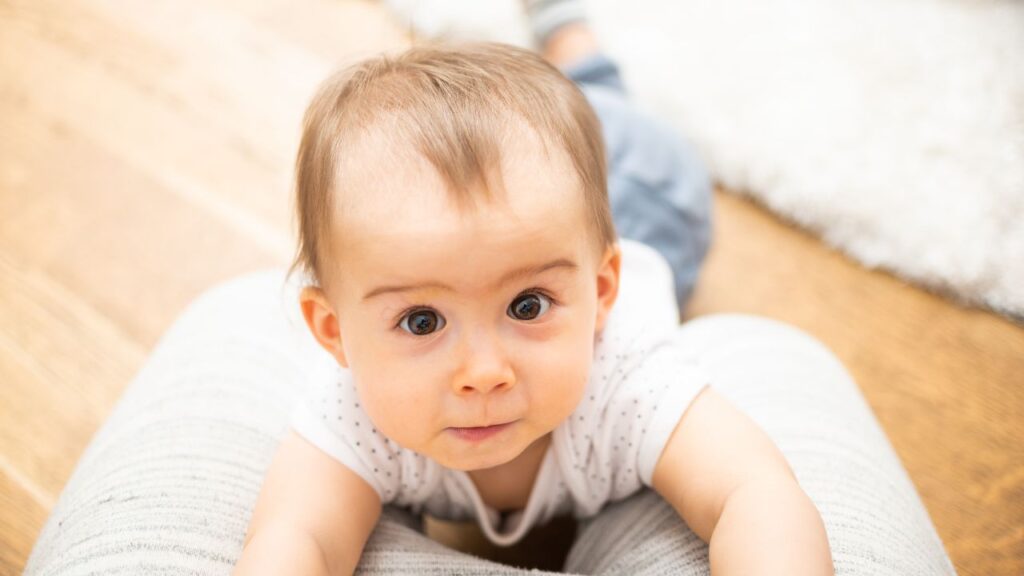As a parent watching your curious baby explore their world, you may have noticed your little one bend to look between their legs more than once. While the behavior can seem entertaining or even puzzling at times, it turns out there’s science and developmental factors behind why babies want to see what’s going on down there.
Understanding the reasons for this common baby looking between legs phenomenon will help you support your baby through the self-discovery process. From physical growth to cognitive milestones, looking between legs plays an insightful role. Let’s uncover some fascinating facts behind why babies are intrigued to gaze at what lies below!
Why Do Babies Look Between Their Legs?
Babies use their senses to make connections with their surroundings. Vision, hearing, taste, touch and vestibular stimulation all contribute to crucial neural pathways forming in a baby’s rapidly developing brain. Looking between their legs allows them to integrate the visual perspective of their body within the greater physical experience.
As they gain control moving their head, arms and upper body first, the lower half still contains an air of mystery. Stretching, reaching and bending offers them a chance to solve the puzzle of what exactly is attached down there! Understanding the link between movement and visual response satisfies their innate infant curiosity.
As early as 2-3 months old, babies enjoy observing their own hands and exploring how their movements create responses in mobiles or toys above them. Tracking the connection between “If move hands, toys move too” forms foundations for more complex problem solving.
By 4 months when looking between legs begins, cause-and-effect cognitive tiles start solidifying. Finding they can bend and maneuver their body to glimpse new views, then return upright connects learning across neural regions.
The delight and determination this sparks is all part of developmental design! Parents can facilitate bringing together baby’s senses, mobility, vision and cognition through games like peek-a-boo or naming body parts.
Superstitions and Parenting
You may have heard odd superstitions around babies gazing between their legs as well. Some cultures believe it indicates the baby can see spirits or is interacting with deceased ancestors! Of course no evidence supports this, but it illustrates the air of magical mystique that still surrounds parenting young ones.
There’s no need to alter your baby behavior based on superstitious ideas. Look at it simply as a means for them to discover their body and environment through their senses. Support their learning process by allowing safe, supervised exploration according to their toddler development.
You’ll likely hear many wise tales and community parenting beliefs as your child grows. Take them as opportunities to connect with your culture and the village helping raise your child. But refer to science-backed developmental guidance as well when making decisions.
Discuss any concerns emerging from rigid rules around pregnancy signs or baby behaviors with your pediatrician. Finding alignment between ancestral wisdom and current child development understanding supports both tradition and health.
Rather than strict dos and don’ts, focus on encouraging baby’s self-trust through playful experiments. They learn best through feeling empowered, not over-controlled. This builds confidence and willingness to engage with their community as well.

Discovering Their Body
From around 4 months old, babies become increasingly aware of themselves as separate beings from caregivers. Part of this self-discovery involves looking at hands, feet, toes and other parts of their bodies coordinating senses together.
Reaching the discovery phase between 4-6 months, they bend, twist and turn to visually examine what exactly is attached between those chubby legs! Learning about their genitalia and other parts down there contributes to early body mapping in the brain. This will expand later on into greater understanding of anatomy and developmental changes.
As your baby bends, grabs at their feet or looks between their legs, think of it as self-orientation rather than random movements. Knowing “what’s that?” is all part of figuring themselves out amidst so much newness in sensation and perception. Support their learning by talking or singing to them about body parts when they’re investigating. This combines language areas stimulation too for whole brain integration.
Early body part familiarization through songs and naming prepares baby for understanding growth changes ahead too. Knowing the correct anatomies from a young age ensures comfort discussing development later.
By 9 months, babies examine differences between themselves and caregivers as well, noticing hair, facial features and voice tones. Comparing bodies, abilities and other characteristics is part of categorization skills emerging.
You can normalize differences by pointing out varying hair colors/textures together. Show baby pictures naming body parts so they become acquainted. Use this early awareness to build self-confidence and respect for others.
Developmental Milestones
Looking between legs coincides with other exciting milestones in your baby’s physical abilities. As they learn to roll over, sit up, scoot and crawl, visual perspective shifts dramatically. What was once just a place to eat and sleep has transformed into a whole world of possibility!
Lying on their back, crib toys and mobiles may have been a baby’s entire field of vision early on. Developing motor control opens up new dimensions, quite literally! Tracking movement between limbs while crawling or cruising furniture is connected to looking between legs as well.
The vestibular system governing balance, equilibrium and spatial awareness also undergoes significant changes. From 2 months old, babies begin showing preferences for certain positions, movements and visual perspectives. This includes enjoying feeling upside-down and inverted positions many parents discover by accident!
As your baby gains mobility and activation of their vestibular system, looking between their legs serves self-regulatory purposes too. If they feel overwhelmed by too much motion or new perspectives, bringing their head down low can feel centering and calming. The posture blocks out visual stimulus, allowing them to reconnect and feel settled within themselves.
The interplay between developing vision, vestibular sensations and proprioceptive feedback supports many future skills. Spatial reasoning for math, getting dressed, refined motor coordination and bodily awareness all connect!
Allow baby to playfully explore these intersections through floor freedomsupervised check-ins. Stop to name play activities together, interpreting their experiments. This helps integrate experiences with language.
Pro tip: gentle baby massages support proprioception too! Added touch input helps baby map and trust bodily signals, useful for self-regulation and confidence long-term.
| AgeMilestoneSignificance2-3 monthsLearns cause & effect from moving bodyBuilds cognitive foundations4 monthsIncrease body awareness and curiosityMotivates purposeful movement6 monthsScoots/crawls with perspective shiftsReinforces spatial concepts9 monthsCompares self to others noticing differencesSupports categorization ability |
|---|
It’s Fun and Calming for Babies
Speaking of calming effects, looking between their legs is actually entertaining and self-soothing for many babies! The unusual upside-down view and contorted body positioning provides sensory input that many babies and toddlers enjoy repeating.
Physical development means newfound freedom and control over limbs. After months of static existence, babies relish moving self-directedly even if it seems silly to us. Just like peeking through rails or spinning in circles, looking through their legs makes them giddy. Support this playful baby behavior by smiling, keeping baby safe and letting them know you enjoy seeing them filled with joy as they explore.
Being inverted can have emotional regulating effects too when babies need to recharge. The blood rushing to their head accompanied by visual restriction serves to block out overstimulation. Adding sound, touch or movement like gentle back rubs or rocking can augment this reset. Utilize this natural tendency for self-care from a young age.
Upending expectations and inverting their typical routines makes babies giddy partly because it activates alertness mechanisms. The novelty creates surges in feel-good neurochemicals supporting learning.
Harness this positive emotional kick by introducing new sensations and games. Turn nap times upside down once in a while. Show silly face pictures and make play tunnels together. It builds cognitive flexibility, problem solving skills and capacity to self-entertain.
Balance novelty with consistency in daily rhythms though for optimal development. Humans – babies included – thrive through environmental security plus change. Work expanded routines around secure attachment foundations.

Can Babies See Clearly Between Legs?
While babies delight in their contorted investigations down below, just how much can they actually see in such awkward positions? You may have noticed they strain, adjust and maneuver trying to get a better look. So what visual range and clarity is possible when gazing between their legs?
Newborns have around 20/400 vision on average, meaning they see at 20 feet what older children and adults can see clearly from 400 feet away. By six months, visual acuity sharpens closer to 20/100 and by age three around 20/20. However at all stages, Dynamic Visual Acuity also plays a role.
This refers to the ability to see objects accurately while either the object is moving, or the viewer themselves is in motion. Tracking moving objects requires visual perceptual skills still developing in infants and toddlers. So while eyesight might be 20/20 when looking straight ahead, glare, angles and motion impact visibility.
Babies don’t have the eye muscle control for sharp peripheral vision adults have either. Combine awkward positions with subconscious tips and sways while holding the pose and visual input becomes puzzling! Frustrating perhaps, but the challenge only fuels their determination and curiosity further. Support their exploration by moving toys around or flipping books upside down to show it’s okay to see things differently.

When to Be Concerned
While most babies grow out of bending gymnastics as mobility increases, some underlying issues could be indicated in rare cases. Consistently arching backwards or looking between legs beyond normal developmental windows might reflect low muscle tone or connective tissue disorders.
Repetitive gazing between legs for lengthy periods may constitute sensory-seeking behavior related to autism, ADHD or other disorders. Note other developmental delays or social disconnects too if concerned. Sharing videos with your pediatrician can help determine if further evaluation for physical therapy or early intervention services is recommended.
Most often though, contortionist moves resolve on their own within regular developmental timelines. Track progress at regular checkups and bring up any worries with your child’s doctor sooner than later. Early supportive care makes all the difference in helping both baby and worried parents feel confident!
| Milestone | Average Age Range | Red Flags if Not Reached | Next Steps if Concerned |
|---|---|---|---|
| Holds head up | 1-4 months | By 6 months | Discuss tummy time with doctor |
| Rolls both ways | 4-6 months | By 9 months | Physical therapy evaluation |
| Sits independently | 5-7 months | By 10 months | Call early intervention program |
| Crawls fluidly | 6-10 months | By 1 year | Request occupational therapy referral |
Facilitating Healthy Exploration
Looking between their legs forms part of your baby’s natural learning process as they make sense of the world. You can facilitate healthy exploration and play by incorporating the following parenting activities:
- Let baby bend, twist and turn during floor play ensuring the area is clear and safe. Position yourself nearby to spot them trying new moves.
- Invert and angle floor mirrors allowing baby to glimpse themselves from upside-down. Celebrate their curiosity!
- Demonstrate looking between your legs too (as able) to validate the experience for them
- Encourage motor skills development with baby gym sets promoting coordination
- As baby grows into a toddler, introduce fun songs/games like “Head, Shoulders, Knees and Toes” reinforcing body part names
- Set up obstacle courses from furniture allowing them to pop up and down and see between legs
- Ensure baby is meeting physical milestones through tracking growth and discussing any concerns with your pediatrician early on for supportive guidance.
- Stimulate vestibular development through slow rocking/bouncing and introduce sitting/standing balance practice.
Revel in their flexible, silly antics knowing it contributes to deeper understanding. Share in their gleeful adventures by taking on fun fresh perspectives too!
The Takeaway
Watching your baby curiously contort themselves to look between their legs can be perplexing, but is entirely normal! It serves their development through self-discovery, physical ability improvements and sensory processing play. Pay attention for delays, but otherwise rest
FAQ – Baby Looking Between Legs
What are some signs my baby is starting to explore their body?
Around 4-6 months you’ll notice your baby bending, twisting, grabbing their feet, and looking closely at their hands. An increased curiosity about what’s between their legs can start happening too. These are all healthy signs of early self-discovery and orienting to the connection between their bodies and behaviors. Respond positively by naming body parts, singing songs, and supporting safe sensory exploration during supervised play.
Why does my baby arch their back or walk on their head?
Contorting into silly positions is entertaining and stimulating for many babies once mobility increases. Seeking an inverted perspective by peering at the world upside-down or walking on their head provides vestibular input and activates alertness. Allow this playful experimentation during floor time, praising their boldness. Just take safety precautions to avoid accidents. It may look extreme but builds body awareness.
My baby stares oddly between their legs for stretches. Should I redirect them?
Consistently fixating in unusual ways can occasionally indicate a developmental difference or sensory need. Note if it replaces social interaction or coping with stimuli. Redirect gently rather than strictly controlling the behavior. Movement breaks can shift focus. If accompanied by other delays in growth milestones, discuss videos of the behavior with your pediatrician to determine if additional support would help.
How can I teach my baby body part names?
Seize opportunities during bath time or diaper changes to name anatomy like arms, feet, eyes, etc. Sing silly songs pairing the words with touches, gestures and movements. “Head, shoulders knees and toes” links words to coordination. Read picture books labeling diverse bodies as well. Use correct terms for genitalia specifically, modeling comfort speaking about bodies. This builds healthy early body image.
What are the risks of letting my baby stand on their head?
Supervised headstanding helps strengthen upper body and shoulders supporting gross motor skills. Spot baby gently, never forcing positional play against their wishes or ability. Provide soft surfaces and remove hazards to prevent injury if they topple over. Avoid compression across the fontanels/soft spots on top of the skull and redirect if displaying discomfort. Using mats designed for infant safety eliminates risks while growing bravery.











